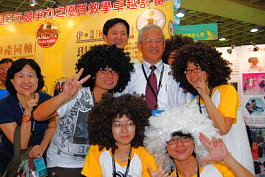"Achievements of the Teaching Excellence Project and the Teaching Resource Center" Combined Exhibition
Date:

Minister of Education, Cheng Jei-cheng, emphasized in his speech at the opening ceremony that it has been three years since the subsidy program took effect in 2005 and the efforts of the Teaching Excellence Project have paid off. At present, the Ministry of Education has secured additional funding from the Executive Yuan by changing the Teaching Excellence Project budget from ad-hoc to regular thus enabling it to continue with the program. This is to encourage domestic universities to pay more attention to teaching quality.
The Teaching Excellence Project subsidy has prompted many universities to initiate Internet Teaching Platforms by starting Remedial Teaching, Cross-Disciplinary Curricula, University Freshman Support Mechanisms and Service Learning. In addition to improvements in the hardware and software of teaching facilities, universities have been gradually extending their field of attention to teaching quality, teaching results, ethics education and social services.
In the past, domestic universities tended to focus on research rather than education, by allocating more resources and effort on the enhancement of research results. As a result, teaching quality was not so much of a focus. Because of this it is imperative to improve teaching quality at universities.
The Teaching Excellence Project was proposed by the Ministry of Education in December 2004. A NT$1 billion budget was allocated for 2005 to set up an incentive mechanism where universities competed with their proposals, in order to encourage them to upgrade teaching quality. After stringent screening, 13 universities were chosen for 2005. Due to the wide recognition of the project by universities and all concerned parties, the annual budget was increased to NT$5 billion from 2006. Vocational colleges, and education and physical education universities/colleges were also incorporated into the project. In 2006, a total of 28 higher education institutions and universities of education and 30 vocational colleges received subsidies (i.e. 58 schools). In 2007, a total of 30 higher education institutions and universities of education and 30 vocational colleges received subsidies (i.e. 60 schools received subsidies).
Measures and Effects of the Teaching Excellence Project on Enhancement of Teaching Quality
1. Establishment of Professional Development Organizations for Teachers |
The 30 universities and colleges that received subsidies have all established professional development organizations for their teachers. Assistance to teachers is provided in the form of demonstrations by outstanding teachers, teaching seminars and workshops of all kinds and with a mechanism for teachers to provide feedback. All the measures aim to encourage teachers' participation. Consulting services are provided by outstanding teachers in the areas of curriculum design, teaching material editing and writing, teaching technique improvement, class management and emotional management. These services have been well received and are highly regarded by teachers utilizing them. |
2. Formulatnio of a Mentoring Mechanism for New Teachers |
Manuals for new teachers are compiled so as to bring new teachers up to speed in the understanding of their teaching environments. Some schools have deployed blogs or teaching resource websites to provide a variety of teaching information. To support new teachers, some schools have teamed up with teaching instructors (as seed teachers) to offer teaching consultation services. In other schools, senior teachers are invited to mentor new teachers to assist in their improvement of teaching standards. |
3. Enhancement of Training and Review Mechanism for Teaching Assistants |
Among the schools that receive subsidies, 23 of them have established a mechanism to train teaching assistants. The support provided by teaching assistants reduces the teaching workload. For example, teaching assistants can help teachers to prepare teaching materials before class and upload materials onto the website. They can assist students in the classroom. After class, they can help students that fall behind by resolving their learning difficulties so that these students can achieve good results eventually. Therefore, all the schools have arranged training programs to enhance professional competency of teaching assistants so as to improve their effectiveness. |
4. Implementation of Teacher Assessments |
In addition to assessment in teaching, research, services and support to students, assessment areas are sometimes expanded in accordance with the nature of the schools. Some schools regard the results of teaching assessments as a key reference for evaluations and promotion of teachers, which in turn protects the learning rights of students. Meanwhile, to reach the targets and goals of this project, all schools have been endeavoring to combine teaching assessments with teacher appraisals/promotions. This is a clear indication of how hard schools have been working to improve teaching quality and focus on teaching skills in order that teachers can pay more attention to the learning experience of students. |
5. Reduction of Teaching Workload |
To reduce teaching workload and enhance teaching quality, schools have come up with certain measures to reduce teacher/student ratios and teaching hours of full-time teachers. They have stepped up the recruitment of good teachers and reduced the number of teaching hours so as to enable teachers to be dedicated in their teaching. |